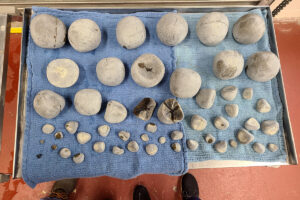Stifle Problems
- Topics: Article, Osteochondritis Dissecans (OCD)
For a sharp-eyed individual, it doesn’t take much to spot a stifle problem: The telltale swelling in the stifle area is a big hint. But the stifle is a complicated joint. Knowing the particular part of the stifle that’s affected and the precise cause of the disorder is critical for implementing the correct therapy and maximizing recovery.
The stifle is a complex hinge joint in the upper hind limb of the horse, and the largest joint in the horse’s body. Its role is to provide unfettered flexion and extension of the hind limb, which allows the horse to move forward with smooth impulsion. The stifle also participates in the passive stay apparatus, which locks the joint to allow the horse to maintain a weight-bearing, straight hind limb for long periods of time while relaxing the other hind limb. Although comparable to the knee joint in humans, the equine stifle is angled when the horse stands still, whereas the human knee is upright.
The stifle consists of several different articulations between the patella (knee cap), the femur (the long upper bone of the hind leg), and the tibia (the inner of the two bones that extends down from the knee to the hock). Explains Melinda H. MacDonald, DVM, PhD, Dipl. ACVS, Assistant Professor of Equine Surgery at the University of California, Davis, "The femorotibial joint cavity of the stifle is further subdivided into medial and lateral (inside and outside) compartments. Two crescent-shaped menisci sit between the femur and tibia; these menisci are cartilage discs that provide congruency between the two bones and help reduce concussion in the joint. Two cruciate ligaments within the femorotibial joint function to stabilize the joint.
"There are also two strong collateral ligaments supporting the joint on either side of the leg," she continues. "The patella is supported from the top (or base) by the quadriceps femoris muscle, on either side by the femoropatellar ligament, and below by three strong patellar ligaments. With normal hind limb movement, the femoropatellar joint moves in unison with the femorotibial joint
Create a free account with TheHorse.com to view this content.
TheHorse.com is home to thousands of free articles about horse health care. In order to access some of our exclusive free content, you must be signed into TheHorse.com.
Start your free account today!
Already have an account?
and continue reading.
Related Articles
Stay on top of the most recent Horse Health news with

















